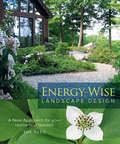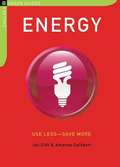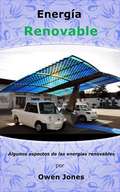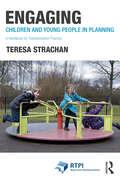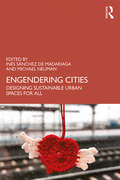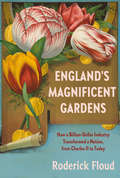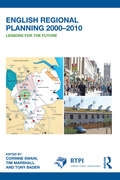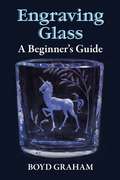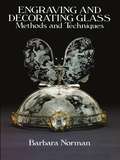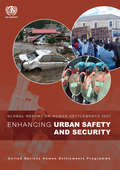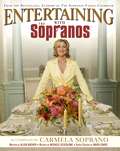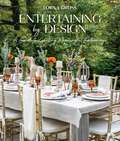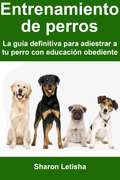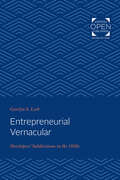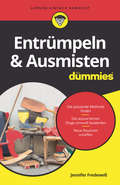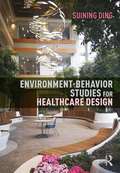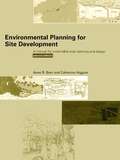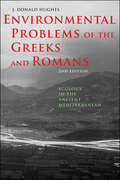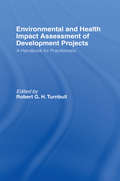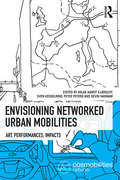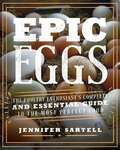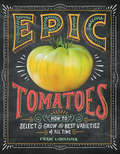- Table View
- List View
Energy Independence: Your Everyday Guide to Reducing Fuel Consumption
by Christine WoodsideEnergy Independence is the essential guide to the most viable and affordable alternative energy solutions for the everyday consumer—including solar panels, wind generators, hydrogen fuel cells, wood, hydro-electric, geothermal heat pumps, and more. For all those seeking either to supplement their traditional fuel-burning furnace or to revamp their home, this book has what they need to get started. They&’ll learn about the most progressive and advanced options as well as tried and true energy conservation techniques. They&’ll learn how much each method costs, and how quickly they will recoup any investment. Also including a chapter on alternative-fuel cars, this book has been revised and updated with the most recent stats, technology, costs, and advice. It is a must for anyone—urbanite, suburbanite, or rural dweller—who relies on traditional oil-burning sources but has decided it&’s high time to be proactive both about cutting fuel costs and achieving freedom from fossil fuel dependence.
Energy-Wise Landscape Design
by Sue ReedResidential consumption represents nearly one quarter of North America's total energy use and the average homeowner spends thousands of dollars a year on power bills. To help alleviate this problem, Energy-Wise Landscape Design presents hundreds of practical ways everyone can save money, time, and effort while making their landscapes more environmentally healthy, ecologically rich, and energy efficient.Combining general guidelines with tips, techniques, and actions, this fully illustrated guide explains the many opportunities our landscapes provide for conserving energy. Readers will learn how to: Lower a home's heating and cooling costs Minimize fuel used in landscape construction, maintenance, and everyday use Choose landscape products and materials with lower embedded energy costs Make a positive difference without a major investment or change in lifestyle Intended for homeowners, gardeners, landscape professionals, and students, the design ideas in this book will work in every type of setting--large or small, hilly or flat, urban or rural. Written in non-scientific language with clear explanations and an easy conversational style, Energy-Wise Landscape Design is an essential resource for everyone who wants to shrink their energy footprint while enhancing their property and adding value to their home.Sue Reed is a registered landscape architect and a specialist in ecological landscape design who has helped hundreds of homeowners create comfortable, livable, and beautiful landscapes that save energy. She is also an experienced writer and teacher whose work specifically focuses on environmentally sound, energy-efficient, and sustainable landscape design.
Energy: 100 Energy-saving Tips for the Home
by Jon Clift Amanda Cuthbert100 energy saving tips for everything in your home or business. Includes suggestions on heating and cooling, lighting, cooking, appliances and much more. Also provides an overview on renewable energy options.
Energía Renovable: Algunos aspectos de las energías renovables (Cómo hacer... #85)
by Owen JonesEnergía Renovable Algunos aspectos de las energías renovables Espero que la información le resulte útil, precisa y rentable. La información de este libro electrónico sobre cómo implementar una estrategia de energía sostenible en el hogar está organizada en 19 capítulos de aproximadamente 500 a 600 palabras cada uno. Espero que sea de interés para aquellos que quieran hacer algo para crear su propia energía para uso doméstico. Como beneficio adicional, le otorgo permiso para usar el contenido en su propio sitio web o en sus propios blogs y boletines, aunque es mejor si los reescribe primero con sus propias palabras. También puede dividir el libro y revender los artículos. De hecho, el único derecho que no tiene es revender o regalar el libro tal como se le entregó.
Engaging Children and Young People in Planning: A Handbook for Transformative Practice (ISSN)
by Teresa StrachanEngaging Children and Young People in Planning places planners’ skills for engagement with children and young people centre stage by discussing several projects delivered or supported by planning students to young people in the Northeast of England. Urban or town and country planning is a largely unfamiliar concept to children and young people. Moreover, in England, the environment in which young people live, play and go to school is shaped by a local planning process which lacks their input. This book explores the nature of the gap between that planning process and the voice of the younger members of the community, as well as the barriers that impede this engagement. It highlights why an engagement process is beneficial for those young people, for the wider community and for the planning process itself. At a time when our relationship with and impact on, the environment is being re-examined, this book challenges the planning professional to identify, develop and reflect upon the engagement skills that will help to transform planning into a more inclusive practice. It will be of use to scholars and practitioners in urban planning, community planning, engagement and children’s rights, whilst supporting their academic and professional development pathways.
Engendering Cities: Designing Sustainable Urban Spaces for All
by Inés Sánchez de MadariagaEngendering Cities examines the contemporary research, policy, and practice of designing for gender in urban spaces. Gender matters in city design, yet despite legislative mandates across the globe to provide equal access to services for men and women alike, these issues are still often overlooked or inadequately addressed. This book looks at critical aspects of contemporary cities regarding gender, including topics such as transport, housing, public health, education, caring, infrastructure, as well as issues which are rarely addressed in planning, design, and policy, such as the importance of toilets for education and clothes washers for freeing-up time. In the first section, a number of chapters in the book assess past, current, and projected conditions in cities vis-à-vis gender issues and needs. In the second section, the book assesses existing policy, planning, and design efforts to improve women’s and men’s concerns in urban living. Finally, the book proposes changes to existing policies and practices in urban planning and design, including its thinking (theory) and norms (ethics). The book applies the current scholarship on theory and practice related to gender in a planning context, elaborating on some critical community-focused reflections on gender and design. It will be key reading for scholars and students of planning, architecture, design, gender studies, sociology, anthropology, geography, and political science. It will also be of interest to practitioners and policy makers, providing discussion of emerging topics in the field.
Engineering for Cats: Better the Life of Your Pet with10 Cat-Approved Projects
by Mac DelaneyThere may be 100 million pet cats in this country, but who says that means they’re domesticated? Sure, they clean themselves, use a litter box, and hunt rodents, but cats are also territorial beasts who think furniture is meant for claw sharpening, and that running water is always better than still. In this inventive, surprisingly funny, and highly entertaining and practical book, Mac Delaney addresses the quirks of cat behavior through the mindset of an aerospace engineer (because that’s what he is!)—and gives us 10 projects that solve the most common sources of friction affecting cats and their doting owners. Take that preference for running water. Because cats don’t trust still water (in the wild, a stagnant pool can harbor disease), they’re often dehydrated and cranky. Here’s how to build not one but two different fountains that will provide fresh, moving water. Or another problem: Cats, diminutive in stature, can feel inferior around humans, causing them to act out in negative ways. The solution: Erect a cat shelf on your wall, giving your pet a prime perch and a height advantage. And that furniture scratching problem? Construct the Cat Cave—it has angled surfaces for optimal scratching, a curved top for ergonomic lounging, a carpeted interior for perfect napping, and an escape route out back for emergency exits. For any cat lover with a modicum of DIY skills, here’s a whole new approach to living happily ever after with your pet(s).
England's Magnificent Gardens: How a Billion-Dollar Industry Transformed a Nation, from Charles II to Today
by Roderick FloudAn altogether different kind of book on English gardens—the first of its kind—a look at the history of England&’s magnificent gardens as a history of Britain itself, from the seventeenth-century gardens of Charles II to those of Prince Charles today. In this rich, revelatory history, Sir Roderick Floud, one of Britain&’s preeminent economic historians, writes that gardens have been created in Britain since Roman times but that their true growth began in the seventeenth century; by the eighteenth century, nurseries in London took up 100 acres, with ten million plants (!) that were worth more than all of the nurseries in France combined. Floud&’s book takes us through more than three centuries of English history as he writes of the kings, queens, and princes whose garden obsessions changed the landscape of England itself, from Stuart, Georgian, and Victorian England to today&’s Windsors. Here are William and Mary, who brought Dutch gardens and bulbs to Britain; William, who twice had his entire garden lowered in order to see the river from his apartments; and his successor, Queen Anne, who, like many others since, vowed to spend little on her gardens and instead spent millions. Floud also writes of Frederick, Prince of Wales, the founder of Kew Gardens, who spent more than $40,000 on a single twenty-five-foot tulip tree for Carlton House; Queen Victoria, who built the largest, most advanced and most efficient kitchen garden in Britain; and Prince Charles, who created and designed the gardens of Highgrove, inspired by his boyhood memories of his grandmother&’s gardens. We see Sarah, Duchess of Marlborough, who created a magnificent garden at Blenheim Palace, only to tear it apart and build a greater one; Deborah, Duchess of Devonshire, the savior of Chatsworth&’s 100-acre garden in the midst of its 35,000 acres; and the gardens of lesser mortals, among them Gertrude Jekyll and Vita Sackville-West, both notable garden designers and writers. We see the designers of royal estates—among them, Henry Wise, William Kent, Humphrey Repton, and the greatest of all English gardeners, &“Capability&” Brown, who created the 150-acre lake of Blenheim Palace, earned millions annually, and designed more than 170 parks, many still in existence today. We learn how gardening became a major catalyst for innovation (central heating came from experiments to heat greenhouses with hot-water pipes); how the new iron industry of industrializing Britain supplied a myriad of tools (mowers, pumps, and the boilers that heated the greenhouses); and, finally, Floud explores how gardening became an enormous industry as well as an art form in Britain, and by the nineteenth century was unrivaled anywhere in the world.
English Regional Planning 2000-2010: Lessons for the Future (RTPI Library Series)
by Tim Marshall Corinne Swain Tony BadenEnglish Regional Planning 2000-2010 chronicles a vital feature of recent UK planning activity, during the period of the Blair and Brown Labour governments up to 2010. It deals particularly with the regional scale of planning during these years, whereby large steps forward were made, but where policy making often proved very controversial. One purpose of the book is to learn from the many areas of policy development, method and skills which evolved during the decade up to 2010. This will mean that a future return to strategic planning should not have to reinvent the wheel. This book also helps to inform such planning in the rest of the developed world where higher-level planning is more prevalent. The book has eight chapters written by experts active in English regional planning during these years, alongside two chapters by the editors introducing and concluding on the experience as a whole. Thematic topics covered include the way in which housing and employment development was tackled in the varying English regional contexts, and the growing influence of transport and environmental factors on the spatial strategy. Process elements covered include how policy was made through public consultation and working with numerous stakeholders (economic, social, environmental), how the public examination of issues was organised, followed by final consideration by central government, and how monitoring informed the next policy review. The authors do not gloss over the difficulties encountered in the highly contested world of English local and regional politics, or the ways in which central government management of the regional planning process made life on the ground difficult for those engaged in the process. Nevertheless the account as a whole shows how a wealth of innovative and forward looking practices were developed. This multi-faceted study contributes to the understanding of how strategic planning can provide the framework for guiding spatial change and allocating resources, looking to a long-term sustainable future.
Engraving Glass: A Beginner's Guide
by Boyd Graham"Lucidly written and illustrated." — The Glass EngraverIf you've ever admired the exquisite beauty and craftsmanship of Steuben, Tiffany, Orrefors, or other fine engraved glass and wished you could engrave glass yourself, this book is for you. It provides step-by-step instructions for diamond-bur engraving, from making the first cut to displaying the finished work.The author, a prize-winning engraver, provides a detailed summary of tools and equipment you will need and suggestions for setting up your workshop, along with easy-to-follow practice exercises to give you a feel for working with glass and glass-engraving equipment. Mr. Graham then guides students through four complete projects, ranging from a simple tree design to a more complex flower engraving.Here are other practical features that make this book ideal for the novice: a useful discussion of design considerations and applications, review of supplemental tools and advanced techniques, expert advice on choosing glass, suggestions for the arrangement and lighting of finished pieces, and more. Over 100 helpful illustrations enhance the text.With this inexpensive book as your guide, you'll find learning the fundamentals of glass engraving far easier than you might have imagined. Simply written and easy to understand, Engraving Glass: A Beginner's Guide is your personal invitation to enjoy the challenges and satisfactions of this rewarding craft.
Engraving and Decorating Glass: Methods and Techniques
by Barbara NormanThe history of glass and glass decoration extends back at least to the ancient Egyptians, who made small vessels of dark glass and decorated them with glass threads of contrasting colors. Occasionally glass vessels were also engraved on the lapidary's wheel. Today, the ancient art and craft of decorating glass continues to flourish among artists and crafters attracted by its combination of artistic beauty and skilled craftsmanship. Unfortunately, until the publication of this book, there were few if any practical instruction guides for beginners in this exciting and deeply rewarding field.A well-known British artist and glass engraver, Barbara Norman has exhibited her glass widely and has won numerous awards. In this clear, profusely illustrated guide, she offers a comprehensive introduction to the history, materials, tools, and techniques of glass engraving and other forms of glass decoration.After introductory chapters on the development of glass, methods of glassmaking, decorating techniques and choosing glass, the author discusses various engraving techniques in detail: diamond point engraving, drill engraving, and copper-wheel engraving. Aspiring glasscrafters will also find excellent coverage of such interesting techniques as gold engraving under glass, painting glass, and applying glass to glass: mosaics, glass collage, glass fusing and glass forming. Most of the methods do not require a studio or workshop and call for relatively inexpensive materials.Ideal for the novice or moderately experienced glassworker, this well-written, easy-to-follow guide will enable glasscrafters to bring decorative beauty and artistic flair to glasses, tumblers, bowls, vases, plates -- almost any glass object. Beautiful engraved or decorated glass is perfect for personalized gift-giving or for adding a note of elegance to any home.
Enhancing Urban Safety and Security: Global Report on Human Settlements 2007
by Un-HabitatEnhancing Urban Safety and Security addresses three major threats to the safety and security of cities: crime and violence; insecurity of tenure and forced evictions; and natural and human-made disasters. It analyses worldwide trends with respect to each of these threats, paying particular attention to their underlying causes and impacts, as well as to the good policies and best practices that have been adopted at the city, national and international levels in order to address these threats. The report adopts a human security perspective, concerned with the safety and security of people rather than of states, and highlights issues that can be addressed through appropriate urban policy, planning, design and governance.
Entertaining With The Sopranos
by Carmela SopranoFans of a certain multi-award-winning HBO dramatic series will enjoy this ultimate guide to making every event the perfect occasion, served up by the Garden State's most gracious hostess, Carmela Soprano. From graduation parties to holiday gatherings to pool-side barbecues, Carmela gives you everything you need to keep your personal crew as happy as a clam in red sauce: over 75 delicious new Neapolitan-based recipes created by Michele Scicolone as well as scores of Soprano-approved tips on picking the ideal location, choosing tasteful decorations, whipping up the best drinks, and selecting the right music.
Entertaining by Design: A Guide to Creating Meaningful Gatherings
by Lorna GrossDiscover the art of effortless entertaining with 17 seasonal gatherings made simple, stylish, and soulful, complete with 18 recipes and fabulous decor tips. "In this breezy debut, interior designer Gross shares ideas on how to host sophisticated events for a variety of occasions. . . This will spark hosts&’ imaginations." —Publishers Weekly "Full of great color photographs of party environments and place settings that readers will want to copy next time they host an event." —Booklist &“Lorna brings style and joy to everything she does, whether designing a room or setting the table. Now, we can delight in her magical world!&” —Steele Marcoux, Editor-in-Chief Veranda Magazine From interior designer and style maven Lorna Gross, Entertaining by Design is a collection of accessible gatherings, organized by season, from a small dinner to post-Christmas breakfast celebration. Each gathering is designed to be instructional, inspirational, and doable for anyone by using tableware and decorations you may already have along with carefully chosen decorative items like place cards or serving platters that can cost as little or as much as your budget allows. Each gathering includes suggestions for the best way to invite your guests—sometimes, that's just a well-thought-out email—types of tableware, music suggestions to set the mood, and a color scheme to tie everything together. Lorna has shared a few of her favorite recipes that are satisfying, delicious, and certain to get the party started. In a world where we're constantly busy, it's easy to think there is no time to plan a party, but Lorna proves that with her simple instructions, streamlined tips, and a little planning, any of these gatherings can be accomplished. Whether you believe you don't know how to create a gathering or you just think you don't have the time, gorgeous photos throughout the book encourage readers by showing how easy it can all be.
Entrenamiento de perros: La guía definitiva para adiestrar a tu perro con educación obediente
by Sharon LetishaEste libro está escrito para proporcionarte conocimientos y consejos sobre cómo criar y entrenar la obediencia de tu perro, cómo educar tu cachorro, trucos y juegos. También aprenderás sobre problemas comunes con las razas de perros y cómo cuidarlos con métodos comprobados paso a paso. No lo dejes todo al azar o al ensayo y error. Si no tienes ni idea de cómo críar adecuadament a tu perro, es probable que termines frustrado y tu amigo se sienta no deseado. ¡Has de tu viaje juntos una aventura significativa!
Entrepreneurial Vernacular: Developers' Subdivisions in the 1920s (Creating the North American Landscape)
by Carolyn S. LoebDuring the 1920s, enterprising realtors, housing professionals, and builders developed the models that became the inspiration for the subdivision tract housing now commonplace in the U.S.Originally published in 2001. Suburban subdivisions of individual family homes are so familiar a part of the American landscape that it is hard to imagine a time when they were not common in the U. S. The shift to large-scale speculative subdivisions is usually attributed to the period after World War II. In Entrepreneurial Vernacular: Developers' Subdivisions in the 1920s, Carolyn S. Loeb shows that the precedents for this change in single-family home design were the result of concerted efforts by entrepreneurial realtors and other housing professionals during the 1920s. In her discussion of the historical and structural forces that propelled this change, Loeb focuses on three typical speculative subdivisions of the 1920s and on the realtors, architects, and building-craftsmen who designed and constructed them. These examples highlight the "shared set of planning and design concerns" that animated realtors (whom Loeb sees as having played the "key role" in this process) and the network of housing experts with whom they associated. Decentralized and loosely coordinated, this network promoted home ownership through flexible strategies of design, planning, financing, and construction which the author describes as a new and "entrepreneurial" vernacular.
Entrümpeln und Ausmisten für Dummies (Für Dummies)
by Jennifer FredewessWir alle kennen das - hier eine Kleinigkeit als mögliches Mitbringsel eingekauft, dort das günstige Sonderangebot für einen neuen Küchenhelfer mitgenommen und an den preisreduzierten Schuhen vorbeizugehen, hat auch nicht geklappt. Und schon häufen sich Dinge an, die man nicht unbedingt braucht und die zu Gerümpel werden. Jennifer Fredeweß schärft Ihren Blick für die Dinge um Sie herum, die Sie nicht mehr benötigen. Und dann heißt es ausmisten. Die Autorin zeigt die Vor- und Nachteile beim Ausmisten mit Freunden, der Familie, einem Aufräumcoach oder eine Facebook-Gruppe und gibt Tipps, wie Sie planvoll ausmisten, ohne schlechtes Gewissen, sich von Geschenk oder einem einmal liebgewonnenen Gegenstand zu trennen. Sie erfahren, welche Methode am besten zu Ihnen passt, wie Sie Raum für Raum Ihre Wohnung ausmisten und wie Sie die aussortierten Dinge loswerden. Und auf einmal fällt es ganz leicht Entscheidungen zu treffen und sich von überflüssigen Dingen zu trennen.
Environment-Behavior Studies for Healthcare Design
by Suining DingEnvironment-Behavior Studies for Healthcare Design explains how environment-behavior (EB) studies can contribute to healthcare design research and explores how evidence-based theories can be applied and integrated into the healthcare design practice. Drawing on EB theories and the latest research in environment-behavior studies, this book shows how the healthcare environment can positively impact patients' and caregivers' well-being and healthcare organization's efficiency by modifying environmental attributes, such as space configuration, color, lighting, signage, acoustics, and artwork. It addresses a range of healthcare facilities including children's hospitals, long-term care, acute care and outpatient care facilities, and uses a range of evidence-based design research methods, such as interviews, focus groups, observations, surveys and space syntax. The author also explains how research evidence and evidence-based design can be integrated into healthcare design more cohesively in a redefined design process. This book provides a solid conceptual structure that informs a clear map for understanding the EB theories and their applications in healthcare design. This research guide for healthcare design helps students, academics, designers and architects reconsider how to create environments that support patients’ healing and well-being whilst considering efficiency and safety.
Environmental Planning for Site Development: A Manual for Sustainable Local Planning and Design
by Anne Beer Cathy HigginsEnvironmental planning forms the basis of all site development decisions and deals with the factors that must be considered before a site plan can be drawn up. Environmental Planning for Site Development emphasizes the man/nature interface and explains how nature limits and controls what can happen on every piece of land. The text is clearly set out and will help the reader understand exactly what information is needed for a site planning proposal. The book includes a live case study to demonstrate how GIS systems are now assisting in the design and decision process as communities increasingly participate in local decisions. (Local Agenda 21)
Environmental Problems of the Greeks and Romans: Ecology in the Ancient Mediterranean (Ancient Society and History)
by J. Donald HughesHow did ancient societies change the environment and how do their actions continue to affect us today?In this dramatically revised and expanded second edition of the work entitled Pan’s Travail, J. Donald Hughes examines the environmental history of the classical period and argues that the decline of ancient civilizations resulted in part from their exploitation of the natural world. Focusing on Greece and Rome, as well as areas subject to their influences, Hughes offers a detailed look at the impact of humans and their technologies on the ecology of the Mediterranean basin. Evidence of deforestation in ancient Greece, the remains of Roman aqueducts and mines, and paintings on centuries-old pottery that depict agricultural activities document ancient actions that resulted in detrimental consequences to the environment. Hughes compares the ancient world's environmental problems to other persistent social problems and discusses attitudes toward nature expressed in Greek and Latin literature. In addition to extensive revisions based on the latest research, this new edition includes photographs from Hughes's worldwide excursions, a new chapter on warfare and the environment, and an updated bibliography.
Environmental and Health Impact Assessment of Development Projects: A handbook for practitioners
by The World Health OrganizationThis handbook for practitioners in environmental and public health, environmental management, toxicology and ecotoxicology has been prepared by an international group of experts from both developing and developed countries and covers a wide range of topics in both environmental impact assessment and environmental health impact assessment.
Envisioning Better Communities: Seeing More Options, Making Wiser Choices
by Randall ArendtThe author's work has shaped a generation of planners, designers, and landscape architects. In this book, the author brings his insights to a broader public, with a profusely illustrated demonstration of how local officials, planning commissioners, and everyday citizens can work to make their communities more attractive, more habitable, and more sustainable. Despite the widespread acceptance of good design and planning principles throughout the professions, too many of our towns and rural areas remain needlessly ugly and inefficient. In side by side comparisons of similar places and kinds of buildings, the author shows that we need not live amid sprawling, characterless visual blight. Simple design choices and effective municipal decisions can have tremendous impacts on the quality of our communities. Written in the author's well-known clear, accessible, nontechnical style, this book creates a sense of hope for those who face the everyday challenges of working with developers and landowners to create places that make economic, environmental, and aesthetic sense. The author shows us that with diligence, thoughtfulness, and care, we can make our communities better in countless ways.
Envisioning Networked Urban Mobilities: Art, Performances, Impacts (Networked Urban Mobilities Series)
by Kevin Hannam Sven Kesselring Aslak Aamot Kjaerulff Peter PetersEnvisioning Networked Urban Mobilities brings together scientific reflections on the relations of art and urban mobilities and artistic research on the topic. The editors open the book by setting out the concept grounded in the exhibition curated by Aslak Aamot Kjærulff and refers to earlier work on mobilities and art generated by the Cosmobilities Network. This third volume has two sections, both consisting of short papers and illustrations. The first section is based on artists who were part of the conferences' art exhibition, and the second part is based on theoretical reflections on art and artists.
Epic Eggs: The Poultry Enthusiast's Complete and Essential Guide to the Most Perfect Food
by Jennifer SartellThis isn't a typical egg cookbook or guide to raising chickens, Epic Eggs takes a deep dive on the eggs themselves and tells you how to raise birds that will produce the best eggs you've ever seen. It may be true that most poultry found on small homesteads or in backyards especially are viewed as pets, but they are inarguably pets with benefits--namely eggs. In Epic Eggs, homesteader and writer Jennifer Sartell looks at the eggs of the most common types of poultry you’d find in your backyard: chickens, ducks, geese, turkeys, guineas, and quail. Don’t jump to conclusions! This isn’t an egg cookbook or a guide to raising poultry. Jennifer delves into the eggs themselves and explains reproductive systems, egg anatomy, and how and why different colors are distributed to egg shells. Jennifer will show you a variety breeds of birds, and what sizes, shapes, and even colors of egg they produce; from white to blue, brown, chocolate, olive, and speckled, plus heritage breeds and how to breed for specific colors. Illustrated with fantastic color photography of eggs and their birds, Epic Eggs goes on to address how to optimize living conditionsand diet for the healthiest and most-flavorful eggs, the process of grading and storing eggs, and the eternal washing debate. There’s also discussion of nutrition, baking, cooking, preserving, pickling, and dehydrating. The book ends with advice for homesteaders looking to create business plans and a section on troubleshooting.
Epic Tomatoes: How to Select and Grow the Best Varieties of All Time
by Craig LeHoullierSavor your best tomato harvest ever! Craig LeHoullier provides everything a tomato enthusiast needs to know about growing more than 200 varieties of tomatoes, from planting to cultivating and collecting seeds at the end of the season. He also offers a comprehensive guide to various pests and tomato diseases, explaining how best to avoid them. With beautiful photographs and intriguing tomato profiles throughout, Epic Tomatoes celebrates one of the most versatile and delicious crops in your garden.

